The World of a Russian Village
(folk art in people’s life: rituals, traditions, feasts), (p. 4)
The third hall
 The third hall presents festive culture of a Russian village in the late 19th – early 20th century. The main traditional calendar feasts – the Nativity of Christ, Shrovetide, St. George Day, The Trinity – are illustrated by the exhibition complexes presenting bright festive attributes. The unique threefold mirror, shaped like an image-case, dates back to the 17th century. The mirror is associated with a popular tradition of Christmastime fortunetelling. Its main themes were wedding and family life.
The third hall presents festive culture of a Russian village in the late 19th – early 20th century. The main traditional calendar feasts – the Nativity of Christ, Shrovetide, St. George Day, The Trinity – are illustrated by the exhibition complexes presenting bright festive attributes. The unique threefold mirror, shaped like an image-case, dates back to the 17th century. The mirror is associated with a popular tradition of Christmastime fortunetelling. Its main themes were wedding and family life.
 The fine horse bows, shapely sled for gala rides, small sledges from the Vologda Province for the newly wedded couple’s tobogganing are attributes of the Shrovetide.
The fine horse bows, shapely sled for gala rides, small sledges from the Vologda Province for the newly wedded couple’s tobogganing are attributes of the Shrovetide.
 The Trinity was marked by the decoration of houses and churches with birch branches and ritual dances around birch trees. “The Trinity round dance” is conventionally staged by the gala female and male costumes of the South Russian Provinces. The costumes are decorative. They demonstrate aharmonious combination of various techniques and materials. Women and maiden head-dresses supplement the female costumes of the European areas of Russia.
The Trinity was marked by the decoration of houses and churches with birch branches and ritual dances around birch trees. “The Trinity round dance” is conventionally staged by the gala female and male costumes of the South Russian Provinces. The costumes are decorative. They demonstrate aharmonious combination of various techniques and materials. Women and maiden head-dresses supplement the female costumes of the European areas of Russia.
 Fairs, organized in towns and large villages, were important festive elements. There gathered people from the surrounding places. All famous handicraft centers sold their goods. Pottery was sold from the carts. The Museum displays a large group of traditional ceramic vessels of the 19th – 20th centuries. The vessels are different in function, technique and decoration.
Fairs, organized in towns and large villages, were important festive elements. There gathered people from the surrounding places. All famous handicraft centers sold their goods. Pottery was sold from the carts. The Museum displays a large group of traditional ceramic vessels of the 19th – 20th centuries. The vessels are different in function, technique and decoration.
 The exhibition curators believe, that “The World of a Russian Village” brings us back to the sources of national culture, helps to perceive the optimistic folk world-view, intense way of life, understanding of beauty and kindness.
The exhibition curators believe, that “The World of a Russian Village” brings us back to the sources of national culture, helps to perceive the optimistic folk world-view, intense way of life, understanding of beauty and kindness.
|


